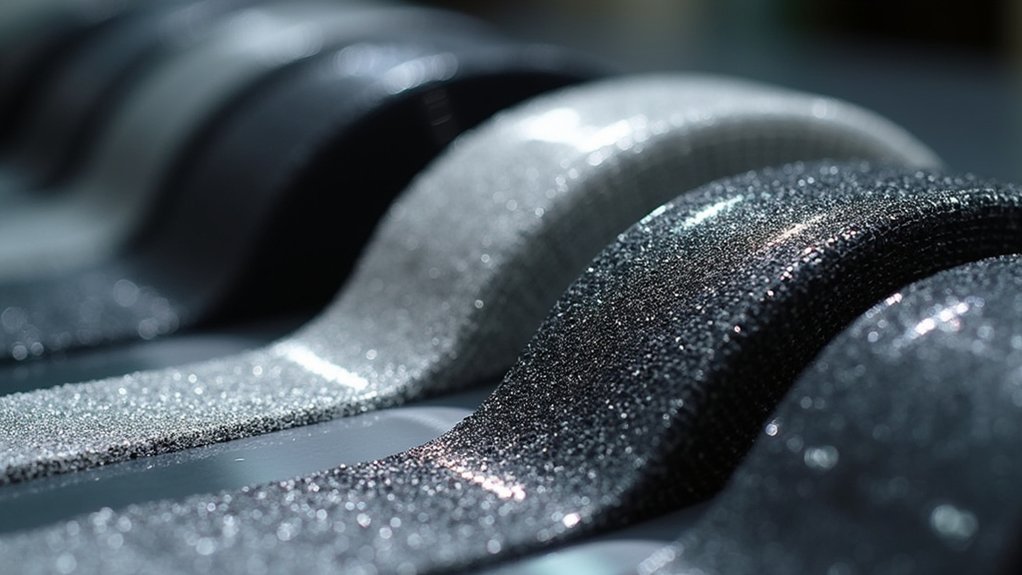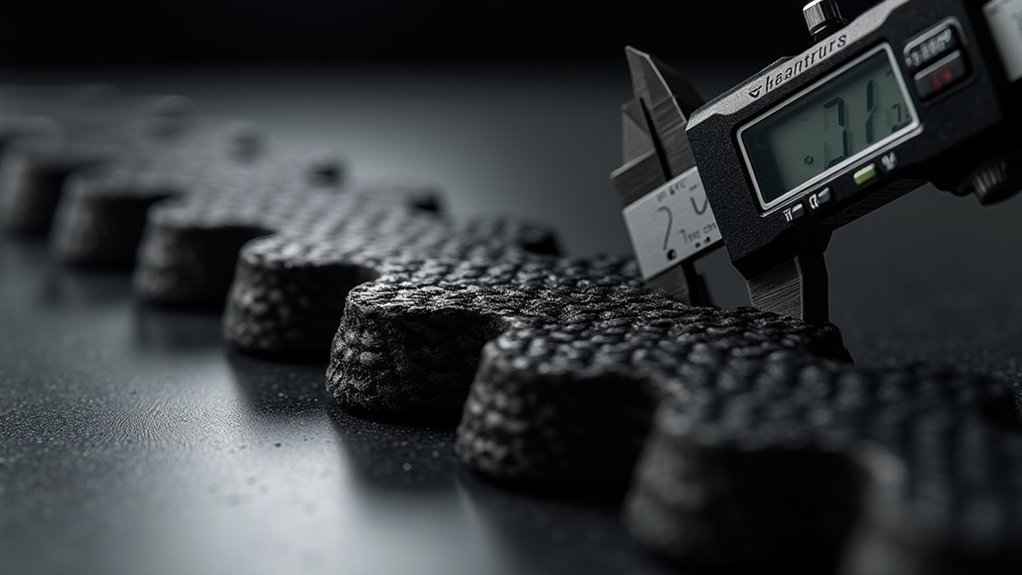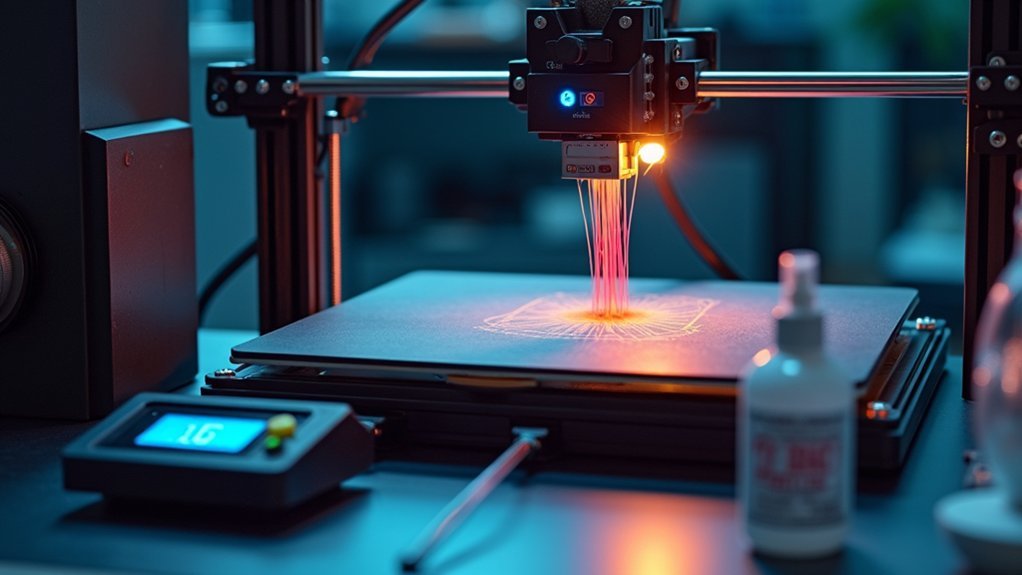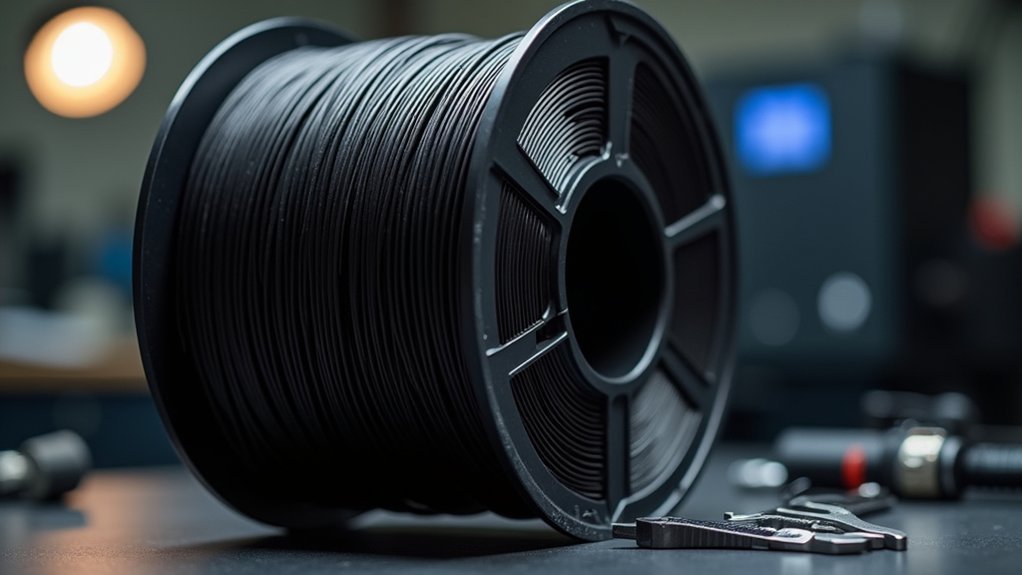To maximize carbon fiber filament strength, you’ll want to select 15-20% fiber content for the best balance of strength and printability. Set your extruder temperature between 210-240°C and use a hardened steel nozzle to handle the abrasive material. Orient your print layers to align with anticipated stress directions and increase layer thickness for better adhesion. Consider annealing your finished parts at 55-60°C for enhanced properties that’ll reveal even greater potential.
Selecting the Right Carbon Fiber Filament and Matrix Material

When you’re selecting carbon fiber filament, the foundation of strength begins with understanding how carbon content and fiber length directly impact your print’s mechanical properties.
Higher carbon percentages—typically 10% to 30%—deliver increased stiffness and strength, while longer fibers provide superior reinforcement and impact resistance compared to shorter alternatives.
Your matrix material choice determines overall performance characteristics.
The polymer matrix you select fundamentally defines your carbon fiber filament’s strength, flexibility, temperature resistance, and overall mechanical performance characteristics.
PLA-based carbon fiber offers excellent rigidity and printability for prototypes.
PETG-based options balance stiffness with ductility and chemical resistance.
Nylon-based filaments excel in high-stress applications with outstanding toughness, though they require higher temperatures and moisture control.
ABS variants increase heat resistance but may warp more.
Consider specialty blends like PETG-HDglass combinations for enhanced layer adhesion and dimensional stability when standard options don’t meet your requirements. Carbon fiber filaments show exceptional resistance to warping during the printing process, which helps maintain dimensional accuracy in your final parts.
Optimizing Print Temperature and Extrusion Settings
Once you’ve selected your carbon fiber filament and matrix material, precise temperature control becomes your primary tool for revealing maximum strength potential.
Set your extruder between 210°C and 240°C – higher temperatures improve flow but can degrade the filament. You’ll need a hardened steel nozzle to prevent carbon fiber abrasion.
Keep your heated bed at 30-65°C depending on your surface type.
Reduce extrusion speeds to prevent jams and improve quality with these stiff composites. Enable retraction settings to minimize stringing issues.
Make sure your filament stays dry to prevent warping failures. Use part cooling fans at 50-100% to control temperatures and prevent overheating.
After printing, anneal parts at 55-60°C for 6-12 hours to dramatically enhance final strength properties. Carbon fiber filaments provide excellent mechanical performance across a wide range of demanding applications.
Mastering Layer Adhesion Through Orientation and Thickness Control

While temperature and extrusion settings form your foundation, layer adhesion determines whether your carbon fiber parts will hold together under real-world stress.
You’ll maximize strength by aligning printed layers with anticipated stress directions—printing perpendicular to forces creates weak spots where layers easily separate.
Increase your layer thickness to improve bonding. Thicker layers create larger melted interfaces between layers, enhancing fusion when combined with slower speeds and higher temperatures.
However, avoid extremely thin layers that cool too quickly and prevent proper adhesion.
Turn off or minimize part cooling fans. Carbon fiber filaments need time for molecular diffusion between layers, and aggressive cooling prevents this critical bonding process.
You’ll achieve stronger interlayer bonds by letting each layer stay molten longer for better fusion. Carbon fiber reinforced materials may present additional adhesion challenges compared to standard polymers, requiring extra attention to these layer bonding techniques.
Setting Up Proper Filament Handling and Feed Systems
Beyond perfecting your print settings, carbon fiber filament’s brittle nature demands meticulous attention to your feed system setup.
Design your filament path with gentle curves only—sharp edges and tight corners cause breakage. Install PTFE guiding tubes to reduce drag and position your spool strategically to minimize tension.
Sharp bends and tight corners spell disaster for carbon fiber filament—design smooth, gradual curves throughout your entire feed path.
You’ll need hardened steel or ruby-tipped nozzles since carbon fibers are highly abrasive. Direct drive extruders work best for controlling rigid filaments and preventing clogs. Consider upgrading to larger nozzle diameters of 0.5mm or more to further reduce clogging risks.
Calibrate your feed tension carefully—too much pressure crushes the filament, while insufficient grip causes slipping.
Store spools in low-humidity environments and pre-dry moisture-exposed filament.
Always inspect for cracks before loading and handle with gloves to prevent contamination that affects feed mechanisms.
Preventing Warping and Dimensional Issues During Printing

Carbon fiber filament’s high thermal expansion coefficient and inherent stiffness make it particularly susceptible to warping—a challenge that’ll destroy even perfectly calibrated prints if you don’t address it systematically.
Start by implementing proper temperature control with consistent hotend settings while utilizing active cooling systems to manage temperature gradients.
Slow your print speeds considerably to improve layer adhesion and reduce stress concentrations through thinner layer heights.
Choose materials wisely—carbon fiber-reinforced nylon or Onyx filaments offer superior dimensional stability compared to glass fiber alternatives.
Always dry your filaments thoroughly before printing, as moisture absorption causes severe warping issues.
Design strategically by placing fibers in bottom layers for increased stiffness and using gyroid infill patterns to distribute stress evenly.
Maintain stable environmental conditions with controlled humidity and minimal vibrations throughout the printing process. Use a heated bed temperature between 80C and 100C to provide optimal adhesion and prevent warping during the printing process.
Post-Processing Techniques for Enhanced Mechanical Properties
You can greatly boost your carbon fiber parts’ mechanical properties through strategic post-processing techniques that go beyond basic printing.
Controlled temperature annealing relieves internal stresses and enhances structural integrity, while proper surface finishing methods improve both performance and durability.
These targeted approaches transform your printed parts from functional prototypes into high-performance components that require less post-processing due to the superior surface quality inherent in carbon fiber materials.
Controlled Temperature Annealing
While 3D printing carbon fiber filaments produces parts with impressive baseline properties, controlled temperature annealing can release their full mechanical potential through precise thermal treatment.
You’ll achieve significant strength improvements by following these critical steps:
- Start with gradual heating – Use controlled ramp rates like 55°C/h to prevent thermal shock and warping in your carbon fiber reinforced parts.
- Maintain plateau temperatures – Hold your parts above the glass phase change temperature (120°C for PET-CF) for 2+ hours, allowing polymer chain realignment.
- Cool slowly and deliberately – Control cooling rates at -20°C/h to 80°C, then -30°C/h to room temperature to minimize internal stresses.
- Support complex geometries – Use sand beds or fixtures during annealing to prevent dimensional distortion in intricate parts. Keep parts attached to the build plate during the annealing process for additional stability.
Surface Finishing Methods
Three fundamental surface finishing approaches can dramatically enhance your carbon fiber parts’ mechanical properties and visual appeal beyond what annealing alone achieves.
Start with progressive manual sanding using wet/dry abrasive papers. Begin with coarse grits to remove surface defects, then move to fine grits for smoothness. Wet sanding prevents fiber damage while reducing dust and scratching.
Apply protective coatings next. 2K spray clear coats provide UV resistance and durability, while epoxy top coats reinforce surfaces and prevent delamination. Tinted clear coats add visual effects without compromising protection. Matte finishes offer superior scratch resistance and hide fingerprints more effectively than gloss alternatives.
For production applications, consider mechanical treatments like media blasting to improve coating adhesion or automated sanding for consistent results.
Always inspect surfaces after each step, checking for remaining defects or coating irregularities before proceeding.
Understanding and Preventing Common Failure Modes
Although carbon fiber filaments possess exceptional strength-to-weight ratios, they’re susceptible to specific failure modes that can compromise their performance in critical applications. Understanding these mechanisms allows you to implement targeted prevention strategies.
- Fiber fracture under tension – Monitor for brittle failure and optimize fiber alignment to distribute loads evenly across your composite structure.
- Matrix cracking and delamination – Strengthen the fiber-matrix interface through proper material selection and processing techniques to prevent perpendicular crack propagation.
- Compressive microbuckling – Control fiber orientation and eliminate manufacturing defects like voids that create stress concentrations leading to fiber kinking. The interaction between closely spaced defects may accelerate damage growth, requiring careful consideration of critical spacing during design and manufacturing.
- Interface debonding – Enhance interfacial shear strength through surface treatments and guarantee adequate fiber-matrix adhesion during manufacturing.
Balancing Fiber Content and Loading for Maximum Performance
Beyond preventing failure modes, you must enhance the fiber content and loading parameters in your carbon fiber filament to achieve peak mechanical properties. You’ll need to strike the perfect balance between fiber density and printability. Too many fibers create surface roughness and dimensional inaccuracies, while too few compromise strength gains.
| Fiber Content | Performance Impact |
|---|---|
| 5-10% | Minimal strength gains, excellent surface finish |
| 15-20% | Ideal balance of strength and printability |
| 25-30% | Maximum strength, challenging print quality |
| 35%+ | Diminishing returns, poor surface finish |
| Variable loading | Inconsistent mechanical properties |
You’ll achieve maximum performance by matching your printer’s capabilities with the appropriate fiber percentage. Confirm your extruder handles the abrasive nature of carbon fibers, and maintain precise temperature control throughout printing. The length of fibers also significantly impacts the final strength, as fiber length affects both the mechanical properties and surface quality of your printed components.
Frequently Asked Questions
How Long Do Carbon Fiber Filaments Last in Storage Before Degrading?
You’ll get about two years from carbon fiber filaments when stored properly in sealed packaging at controlled temperatures. Opened spools degrade faster, so use airtight containers with desiccants for maximum longevity.
Can Carbon Fiber Filaments Damage My 3D Printer’s Nozzle or Extruder?
Yes, carbon fiber filaments will damage your 3D printer’s nozzle and extruder. The chopped fibers are highly abrasive, rapidly wearing down brass nozzles and extruder gears, requiring hardened steel replacements.
What Safety Precautions Should I Take When Printing With Carbon Fiber?
You’ll need proper ventilation to avoid inhaling microscopic particles. Wear N95 masks, nitrile gloves, and safety goggles. Handle filament carefully, store it properly, and keep emergency protocols accessible.
How Do I Troubleshoot Inconsistent Extrusion During Carbon Fiber Printing?
Check your hardened steel nozzle for carbon fiber debris clogs first. Dry your filament thoroughly, reduce printing speed to 54mm/s, and verify your extruder isn’t grinding or stripping the abrasive material.
Are There Specific Slicer Software Settings Optimized for Carbon Fiber Filaments?
You’ll need hardened steel nozzles and higher temperatures between 245-260°C. Set layer heights to 60% of nozzle diameter, use slower print speeds, and enable ironing for better layer adhesion and surface quality.
In Summary
You’ll achieve maximum carbon fiber filament strength by carefully selecting materials, optimizing your print settings, and mastering layer adhesion techniques. Don’t overlook proper filament handling and warping prevention – they’re essential for consistent results. Remember that post-processing can greatly enhance your parts’ mechanical properties. By understanding failure modes and balancing fiber content effectively, you’ll produce components that fully harness carbon fiber’s exceptional strength-to-weight ratio for your most demanding applications.





Leave a Reply